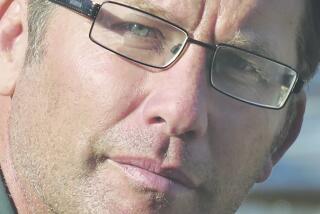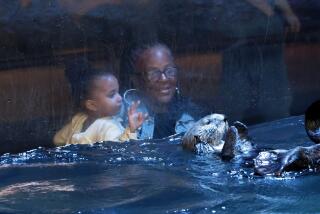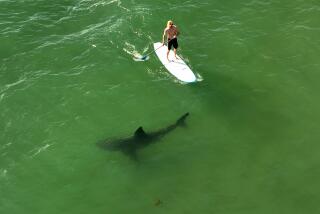‘Blackfish’ has SeaWorld in hot water
- Share via
PARK CITY, Utah — It was Samantha Berg’s dream job: swimming with orcas.
But with only a bachelor’s degree in animal science from Cornell University and no hands-on experience with whales, the then-22-year-old assumed she was not qualified to perform stunts in a SeaWorld pool with the powerful 8,000-pound animals.
Still, she decided to send her résumé to marine parks nationwide in the hopes that she might land a low-level gig and learn more about sea life. To her surprise, she was called in for an audition at SeaWorld’s Orlando park, which asked her to prove her physical acumen by diving 25 feet underwater, picking up a weight, returning to the surface, carrying heavy fish buckets and then jumping up on stage even as she was struggling for breath.
“They’re seeing if you’re physically fit and if you look good in a wetsuit,” she said.
She got the job in 1990, earning $7.50 an hour. But things at SeaWorld were not exactly as she had fantasized.
Berg, now 44, is one of eight former park employees who appear in “Blackfish,” a documentary that received a strong reception when it premiered at the Sundance Film Festival last month and was quickly acquired by Magnolia Pictures and CNN Films. Directed by Gabriela Cowperthwaite, the movie examines whales in captivity and one in particular, Tilikum — an orca that has killed three people, including veteran SeaWorld trainer Dawn Brancheau in 2010.
The film, which will hit theaters this summer and debut on CNN later in the year, explores the psychology of Tilikum, who was born in the wild near Iceland in 1983, captured and sent to a marine park near Vancouver before coming to SeaWorld in Orlando. Separated from his family, he was bullied by other whales as a calf in captivity. Older female whales raked his skin constantly, and Tilikum (“friend” in Chinook) was kept in a small, dark tank for more than 14 hours at a time — factors the movie suggests may have contributed to his aggression later.
SeaWorld is already challenging the film. In a statement, the company said that based on a “very preliminary review” of “Blackfish,” the movie “appears to repeat the same unfounded allegations made many times over the last several years by animal-rights activists.”
“Importantly, the film fails to make the most important point about SeaWorld,” the company said. “The company is dedicated in every respect to the safety of our staff and the welfare of animals.”
Before “Blackfish,” Cowperthwaite, 41, had made one documentary, about urban lacrosse, and knew little about orcas before learning of Brancheau’s death in Florida. At the time, SeaWorld said the whale may have mistaken the 40-year-old trainer’s ponytail for a toy.
The murky details of the incident confused Cowperthwaite, who had brought her children to the company’s San Diego park. Clamoring for more information, she came across “The Killer in the Pool,” a 2010 Outside magazine article about the incident written by Tim Zimmermann. The journalist had already spoken to a handful of former park trainers, and Cowperthwaite asked him to come on board as an associate producer to help her make a film about the topic.
“The trainers spoke in a way that was tangible to me,” said the filmmaker, sitting beside Berg in Park City recently. “They were like my apostles. I got being 20 and wanting to take a fun job. They started out with that same bright-eyed approach to Sea World as I did.”
But finding ex-employees willing to talk about their experiences at SeaWorld wasn’t as easy as the filmmaker had anticipated. Once, she and her film crew flew to meet one man without even knowing his name, and after the group had set up their lights and were ready to begin filming, the subject backed out.
After Brancheau’s death, Berg — who had left SeaWorld in the mid-1990s and is now an acupuncturist in Alaska — was sought after by the news media as a commentator. At first she defended the park’s explanation but became more skeptical as the company cited trainer error as a factor in the death.
“I was shocked by it, but I was still buying into the party line,” said Berg. “I was really deluded, and it’s embarrassing for me to go back and look now at what I did.”
Berg said she came to realize she told numerous things to park-goers that were not true — including that whales live longer in captivity than in the wild. (Orcas can live as long as 80 years in the wild, according to the Vancouver Aquarium.) When she was hired, she was also unaware of Tilikum’s dangerous history or that orcas had injured dozens of trainers over the years.
Some of the most striking footage in “Blackfish” shows trainers being harmed in graphic detail in home videos shot by park attendees. Through a Freedom of Information Act request, Cowperthwaite was able to obtain these as the U.S. Occupational Safety and Health Administration sued SeaWorld after Brancheau’s death.
In May 2012, a Florida judge ruled that SeaWorld killer whale trainers can no longer get into the water with orcas and must be protected by physical barriers. SeaWorld is appealing. Still, the park doesn’t seem to be hurting much: In 2011, attendance at its three locations rose 5.2% to 12.1 million, from 11.5 million in 2010, according to the Themed Entertainment Assn.’s global attractions attendance report.
But other animal activists believe “Blackfish” may reduce attendance at SeaWorld. Louie Psihoyos, the director of the Oscar-winning 2009 documentary “The Cove,” said that if his movie about dolphin slaughter in Japan “gave these guys a black eye, hopefully this will be a knockout punch to SeaWorld.”
Cowperthwaite and Berg hope that SeaWorld will eliminate its orca shows and replace them with more educational exhibits, such as facilities where sick whales are rehabilitated for eventual release. Another option, they say, is for the company to keep whales in a sea pen — a cordoned-off portion of the ocean where whales can still feel the natural rhythms of the ocean but are not confined to a tank.
“Whales are special because you feel that they recognize you, and that small moment throttles you,” said the director. “But we have to be comfortable with the fact that whales may not love us back in that way. I was a mom who took her kids to SeaWorld, lured by the iconic image of Shamu, and didn’t feel quite right about it and didn’t know why. I hope people who see this and still go to the park are at least making an active decision — throwing down that 100 bucks and knowing the truth — not making a passive decision like I was.”
More to Read
Only good movies
Get the Indie Focus newsletter, Mark Olsen's weekly guide to the world of cinema.
You may occasionally receive promotional content from the Los Angeles Times.











